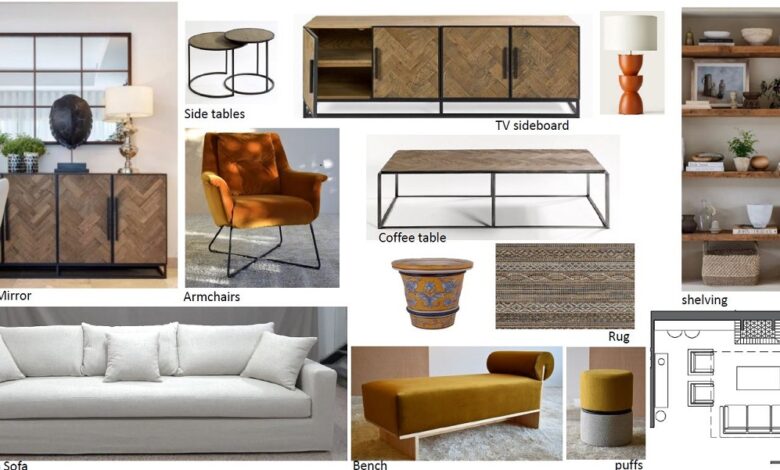Why is interior design important?

Imagine walking into a room with bare walls, mismatched furniture, and no sense of style or personality. How would you feel? Now picture stepping into a space that is thoughtfully designed. Filled with colors that evoke emotion, and arranged in a way that reflects your unique taste. The difference in ambiance is palpable. This is why interior design matters. It goes beyond mere aesthetics; it has the power to shape our moods. Enhance our well-being, and transform any space into an environment that truly feels like home.
The Impact of Interior Design on our Lives
One of the most fascinating aspects of interior design is its ability to profoundly impact our daily lives. It goes beyond creating aesthetically pleasing spaces; it can shape our mood, influence our behavior, and improve our overall well-being. For instance, research has shown that certain colors have direct physiological effects on the human body. Warm hues like red and orange stimulate energy and appetite, making them ideal for dining rooms or kitchens. On the other hand, cooler shades such as blue and green promote relaxation and calmness. Which make them perfect for bedrooms or living areas.
Interior design has a significant impact on productivity levels. A well-designed workspace can enhance concentration and motivation while reducing stress levels. Imagine trying to work in a cluttered environment versus an organized one – the difference is remarkable. Elements like lighting, spatial planning, and ergonomic furniture all play crucial roles in creating an optimal work environment that enables us to perform at our best.
Interior design allows us to express ourselves creatively within our personal spaces. Our homes are reflections of who we are as individuals; they showcase our unique tastes, personalities, and preferences. Designing a space that aligns with your style not only creates a sense of belonging. But also contributes to your happiness and contentment.
Creating a Welcoming and Functional Space
A welcoming and functional space is essential for creating a positive atmosphere in any room. One way to achieve this is by optimizing the layout of furniture and decor to promote flow and ease of movement. Consider arranging furniture in a way that encourages conversation, such as placing couches and chairs facing each other. This creates an inviting environment where people can gather and engage with one another comfortably. Additionally, make sure there is ample space between furniture pieces to allow for easy navigation throughout the room.
Another key element in creating a welcoming space is incorporating natural light. Sunlight has been proven to uplift moods and create a sense of warmth within a room. Maximizing natural light through the use of large windows, skylights, or even strategically placed mirrors can have a profound impact on the overall ambiance of the space.
Incorporating elements of nature into your design can also create an inviting atmosphere. Plants not only add visual appeal but also improve air quality and contribute to a calming environment. Additionally, using organic materials like wood or stone can bring warmth and texture into your space, making it feel more cozy and inviting.
By considering factors such as layout, lighting, and natural elements when designing a space. You can create an environment that is both welcoming and functional for all who enter it. A well-designed room not only looks aesthetically pleasing. But also provides comfort and functionality that enhances every aspect of daily life – from everyday activities to hosting guests or simply relaxing at home.
Reflecting Personal Style and Identity
Your personal style and identity are reflected in the way you design your interior space. Your home is a reflection of who you are and how you want to be perceived by others. It is an opportunity to showcase your creativity and individuality. Whether it’s through bold colors, unique furniture pieces, or personalized artwork, your interior design choices allow you to tell your story and create a space that feels truly authentic.
When reflecting personal style and identity in your interior design, it’s important to consider what inspires you and makes you feel most at home. Are you drawn to sleek lines and minimalist aesthetics? Or maybe vibrant patterns and eclectic décor speak to your lively personality. By understanding what resonates with you on a deeper level, you can curate a space that reflects not just your taste. But also values that are dear to your heart.
Moreover, incorporating elements from different cultures or time periods into your interior design can enhance the storytelling aspect of your space even further. Mixing modern furniture with antique accents creates an intriguing juxtaposition that not only reflects personal style but also reveals layers of complexity within one’s identity. The key here is balance – finding harmony between old and new, traditional and contemporary – resulting in a visually captivating representation of who we are as individuals.
Boosting Mood and Well-being
One often overlooked aspect of interior design is its ability to greatly impact our mood and well-being. The colors, lighting, and overall layout of a space can have a profound effect on how we feel and function on a daily basis. For example, incorporating vibrant colors such as yellows and blues can instantly uplift our spirits and promote feelings of happiness and joy. Additionally, optimizing natural lighting by strategically placing windows or mirrors can help boost our energy levels and improve our overall sense of well-being.
Another key element in boosting mood through interior design is the inclusion of plants and greenery. Research has shown that having indoor plants not only enhances the aesthetic appeal of a space but also has numerous psychological benefits. Being surrounded by nature indoors can reduce stress levels, increase productivity, and even improve air quality. Moreover, caring for plants fosters a sense of responsibility and connection to nature that often brings about feelings of peace and tranquility.
Influencing Perception and First Impressions
When it comes to interior design, one cannot underestimate the power of influencing perception and creating a strong first impression. The way a space is designed has a significant impact on how people perceive it and form their initial opinion. Whether it’s a home, office, or commercial setting. The design choices made in the space can elicit certain emotions and set the tone for further interaction.
Color selection plays a crucial role in influencing perception. Warm hues like reds and yellows can create an inviting and energetic atmosphere. Whereas cooler tones such as blues and greens evoke calmness and tranquility. Additionally, the use of lighting can enhance or obscure certain aspects of a space. Affecting how people perceive its dimensions and features. By using various design elements strategically, designers have the ability to shape perceptions from the moment someone steps into a room.
First impressions are not solely formed based on visual cues but also through sensory experiences. The textures used in interior design can provide tactile stimulation that either enhances comfort or creates an unexpected surprise. From smooth surfaces to rough finishes, each touchpoint contributes to how someone forms judgments about their surroundings. Therefore, careful consideration should be given to materials selected during the design process in order to create memorable experiences that leave a positive imprint.
Conclusion:
In conclusion, the significance of interior design cannot be overstated. It has the power to transform any space into a reflection of one’s personality, preferences, and lifestyle. The careful selection of colors, furniture, and accessories can create an atmosphere that not only pleases the eye but also promotes well-being and productivity.




